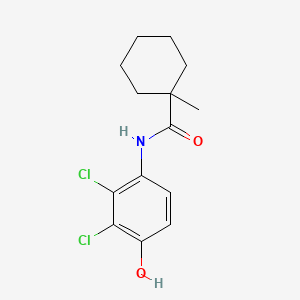D0928 | fenhexamid
| Toxicity | Dose | Time | Species | Model | Method | Action | Positive criterion | Reference |
|---|---|---|---|---|---|---|---|---|
| MEMBRANE POTENTIAL | 8.31±1.15 | human | qHTS-HepG2 | MMP assay | decrease | IC50 | 163 | |
| MEMBRANE POTENTIAL | 17.78 | human | HepG2 | MMP assay | decrease | IC50 | 163 | |
| MEMBRANE POTENTIAL | 36.72±21.22 | rat | hepatocytes | MMP assay | decrease | IC50 | 163 | |
| Pictogram | Signal | Statements | Precautionary Statement Codes |
|---|---|---|---|
 |
H411: Toxic to aquatic life with long lasting effects [Hazardous to the aquatic environment, long-term hazard] |
P273, P391, and P501; (The corresponding statement to each P-code can be found at the GHS Classification page.) | |
 |
Aggregated GHS information provided by 38 companies from 1 notifications to the ECHA C&L Inventory. H411 (100%): Toxic to aquatic life with long lasting effects [Hazardous to the aquatic environment, long-term hazard] Information may vary between notifications depending on impurities, additives, and other factors. The percentage value in parenthesis indicates the notified classification ratio from companies that provide hazard codes. Only hazard codes with percentage values above 10% are shown. |
P273, P391, and P501; (The corresponding statement to each P-code can be found at the GHS Classification page.) | |
 |
Aggregated GHS information provided by 172 companies from 1 notifications to the ECHA C&L Inventory. H411 (100%): Toxic to aquatic life with long lasting effects [Hazardous to the aquatic environment, long-term hazard] Information may vary between notifications depending on impurities, additives, and other factors. The percentage value in parenthesis indicates the notified classification ratio from companies that provide hazard codes. Only hazard codes with percentage values above 10% are shown. |
P273, P391, and P501; (The corresponding statement to each P-code can be found at the GHS Classification page.) | |
 |
H411: Toxic to aquatic life with long lasting effects [Hazardous to the aquatic environment, long-term hazard] |
P273, P391, and P501; (The corresponding statement to each P-code can be found at the GHS Classification page.) | |
 |
H401: Toxic to aquatic life [Hazardous to the aquatic environment, acute hazard] H411: Toxic to aquatic life with long lasting effects [Hazardous to the aquatic environment, long-term hazard] |
P273, P391, and P501; (The corresponding statement to each P-code can be found at the GHS Classification page.) | |
 |
Danger |
H330: Fatal if inhaled [Danger Acute toxicity, inhalation] |
P260, P271, P284, P304+P340, P310, P320, P403+P233, P405, and P501; (The corresponding statement to each P-code can be found at the GHS Classification page.) |
| 126833-17-8 | 2',3'-dichloro-4'-hydroxy-1-methylcyclohexanecarboxanilide; | AKOS015903660 |
| AX8130220 | C18593 | CAS-126833-17-8 |
| CHEBI:81853 | CHEMBL1688541 | Cyclohexanecarboxamide, N-(2,3-dichloro-4-hydroxyphenyl)-1-methyl- |
| DSSTox_CID_12549 | DSSTox_GSID_32549 | DSSTox_RID_78978 |
| DTXSID3032549 | Elevate | F0967 |
| FT-0668488 | Fenhexamid | Fenhexamid 10 microg/mL in Cyclohexane |
| Fenhexamid [ISO:BSI] | Fenhexamid, PESTANAL(R), analytical standard | Fenhexamide |
| HSDB 7273 | J-005440 | KBR 2738 |
| KBR-2738 | KS-000017Q3 | LS-56568 |
| N-(2,3-Dichloro-4-hydroxyphenyl)-1-methylcyclohexanecarboxamide | N-(2,3-dichloro-4-hydroxy-phenyl)-1-methyl-cyclohexanecarboxamide | N-(2,3-dichloro-4-hydroxyphenyl)-1-methylcyclohexane-1-carboxamide |
| NCGC00163791-01 | NCGC00163791-02 | NCGC00163791-03 |
| NCGC00254944-01 | Q63395375 | Q68C3C9P1U |
| SCHEMBL23092 | Teldor | Tox21_301042 |
| UNII-Q68C3C9P1U | VDLGAVXLJYLFDH-UHFFFAOYSA-N | ZINC2384330 |

